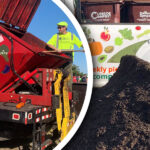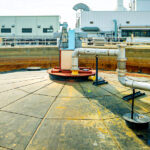BioCycle November/December 2019
AD Facilities Processing Food Waste
The U.S. EPA released “Anaerobic Digestion Facilities Processing Food Waste in the United States (2016)”, the second in a series of three reports; it provides 2016 data. The first was released in 2018, reporting 2015 data. EPA was granted the authority to survey digesters annually for 3 years, from 2017–2019. Each report includes data for three types of AD facilities: Stand-alone food waste digesters; On-farm digesters that codigest food waste; and Digesters at water resource recovery facilities (WRRFs) that codigest food waste.
 For the second report, a total of 198 facilities were surveyed in 2018, and 134 completed the survey: 46 stand-alone digesters, 16 on-farm codigesters, and 72 codigestion systems at WRRFS. Among the findings:
For the second report, a total of 198 facilities were surveyed in 2018, and 134 completed the survey: 46 stand-alone digesters, 16 on-farm codigesters, and 72 codigestion systems at WRRFS. Among the findings:
• Total processing capacity for food waste in all three digester types combined (reported in 2018) is about 24 million tons/year (based on 131 survey respondents).
• Total amount of non-food waste processed in all three digester types combined was about 492 million gallons or 103,952 tons (62 respondents).
• Total amount of biogas produced at digesters in 2016 was 40,304 standard cubic feet per minute (SCFM), equivalent to 126 megawatts (MW) installed capacity or 939 million kilowatt-hours (kWh) generated per year (119 respondents).
• Based on facilities returning surveys in 2018, 31 states have at least one operating digester. States with 10 or more confirmed operating digesters included California (30), Wisconsin (14) and Ohio (11).
Denver, Colorado: Significant Emissions Reduction In Colorado Via RNG
The Colorado Energy Office released a report in late October, “Renewable Natural Gas in Transportation: Colorado Market Study,” which provides a preliminary assessment of Colorado’s potential to produce renewable natural gas (RNG) from major organic waste sources — including landfills, wastewater, animal and food waste — for use in on-road transportation systems. With its growing population and significant agricultural activities, Colorado has considerable potential resources for producing RNG, which could replace approximately 140 million gallons of diesel, or 24 percent of the state’s total diesel consumption for transportation. This would eliminate approximately 1.4 million metric tons of carbon dioxide from fuel combustion annually.
“Colorado has a significant opportunity to produce and utilize RNG in medium- and heavy-duty vehicles throughout the transportation systems in the state,” said Will Toor, executive director of the Colorado Energy Office. “With RNG, the replacement of diesel fuel and mitigation of methane emissions from agricultural, municipal and commercial waste management practices could provide meaningful climate and clean air benefits through reduced greenhouse gas and nitrogen oxide emissions.”
To date, Colorado’s RNG potential remains largely untapped, notes the report. Funding will be available to public and private fleets for RNG vehicles and equipment through Colorado’s recently updated Volkswagen Diesel Emissions Beneficiary Mitigation Plan, a $2.9 billion environmental mitigation trust fund established by Volkswagen Group of America as a result of a court settlement over violations of the Clean Air Act caused by cheating on federal emissions tests. There also may be potential for RNG use in the state outside the transportation sector as well, such as sourcing by electric utilities or natural gas distribution utilities. The Energy Office report also details a range of economic, regulatory, geographic and policy barriers that must be overcome to scale RNG utilization in Colorado.
Albany, New York: Interconnect Guide For RNG
The Northeast Gas Association (NGA) and Gas Technology Institute (GTI) released the Interconnect Guide for Renewable Natural Gas in New York State. Sponsored by several natural gas utilities, “this document is intended to outline a structured approach that all parties can use to begin the technical collaboration processes necessary to understand each stakeholder’s requirements, and ultimately, make each biogas development project a success story for all parties involved,” states the Executive Summary. “It lays out the distinct roles and responsibilities of the pipeline operator and the project developer/producer, and offers a common technical framework describing what each party needs to accomplish. Successful and sustainable introduction of RNG into the natural gas network often depends on multiple variables beyond specific gas quality objectives. Defining these variables and their impact on a project will lead to productive dialogue among all parties.”
The guide has a user friendly technical framework to help reduce overall operational risk for both the developer and pipeline operator, thereby minimizing potential impacts to end use consumers. Key elements include: Interconnect Agreement Evaluation Process Flow Diagram; Producer/Developer and Pipeline Operator Assessment Checklists; Gas Quality and Interchangeability Management Program Matrix; and Raw Biogas and Upgraded RNG Trace Constituents Measurement Matrix and Proposed Sampling Plans. A sample Interconnect Feasibility Analysis Agreement (IFA) and Gas Sales Agreement (Interconnect Agreement) are include in the Appendix to provide a starting place in the evaluation and gas acceptance process and provide essential elements for project/company specific agreements.
Houghton, Michigan: Reducing Agricultural Emissions
In August 2019, the United Nations’ Intergovernmental Panel on Climate Change (IPCC) released its “Climate Change and Land” report, which detailed how climate change is already threatening food and water supplies for humans. The report also states that one significant source of anthropogenic greenhouse gas emissions comes from global food production, including landfilling of food waste. To demonstrate how anaerobic digestion can reduce food-related emissions, Davide Shonnard, a professor of chemical engineering at Michigan Technological University and other Michigan Tech researchers used life cycle assessment (LCA) in a carbon footprint and energy analysis of biomethane (Bio-CH4) from a mixture of food waste and dairy manure in Denver, Colorado.
Key results show that life cycle greenhouse gas emissions for Bio-CH4 production and combustion from AD conversion of food waste and dairy manure, compared to waste landfilling and conventional management of dairy manure, emits -3.5 kilograms (kg) carbon dioxide (CO2) equivalents/kg Bio-CH4 produced. This emission intensity compares favorably to fossil natural gas, which is equal to +4.3 kg CO2 equivalents/kg CH4. The study also suggested that by diverting all of the food waste and dairy manure in the U.S. to AD, 0.41 percent of overall U.S. greenhouse gas emissions (approximately 7 billion tons CO2) can be saved annually.
Los Angeles, California: GHG Emission Reduction Methodology For Dairy Digesters
The Climate Action Reserve (CAR) approved the first three greenhouse gas (GHG) emission reduction methodologies under its Climate Forward program, an initiative to proactively reduce future emissions from investments and activities, instead of waiting for emissions to be generated and then address them after the fact. Climate Forward methodologies provide guidelines for projects that remove GHG emissions or prevent them from being released. Credits, called Forecasted Mitigation Units (FMUs), are issued on an ex-ante basis, meaning they are issued shortly after a mitigation project begins operation.
Dairy digesters are one of the three approved methodologies. The Dairy Digester Forecast Methodology addresses emission reductions associated with the installation, or expansion, and operation of a biogas control system that captures and destroys methane gas from anaerobic manure treatment and/or storage facilities at dairy operations.
Millersville, Maryland: AD Developer Taps Quasi-State Agency’s Expertise
Maryland Environmental Service (MES) has entered into an agreement with Bioenergy DevCo (BDC), a Maryland-based anaerobic digestion project developer, to provide extensive operational expertise to BDC as it designs, sites, constructs, permits, and subsequently operates two anaerobic digestion (AD) facilities planned for the Baltimore area in Maryland. Established in 1970, MES — an independent, self-supporting state agency — operates over 1,000 environmental projects and services across the Mid-Atlantic region, employing over 850 persons. More than two-thirds of MES’ revenues flow to the private sector. MES receives no direct state operations funding and does not have regulatory authority. Under the agreement, MES will:
• Coordinate facility siting, design, permitting, and other necessary operational and commissioning activities, as well as facilities management
• Perform engineering services including QA/QC (quality assurance and control)
• Create construction documents, materials, and equipment and procurement specifications
• Provide environmental documentation and permitting and technical services
In related news, BDC is partnering with Perdue Farms to manage the corporation’s AgriRecycle facility located in Seaford, Delaware, which processes more than 30,000 tons/year of organic material generated by numerous poultry farms and chicken processing plants located in the Delmarva Peninsula. Under the terms of the deal, BDC will manage the existing composting facility over the next two decades, and construct an anaerobic digester that will begin turning organic poultry processing material into both renewable natural gas and a digestate soil amendment.
Yarmouth, Maine: Gas Utility Offers Customers A Renewable Choice
Starting November 1, 2019, Summit Natural Gas of Maine (Summit) customers have a renewable choice via its voluntary renewable attribute program that was recently approved by the Maine Public Utilities Commission (MPUC). “We are excited to be offering our customers a renewable option that allows them to further reduce their carbon footprint through the purchase of renewable attributes,” said Summit’s President and CEO Kurt Adams. “In addition to our voluntary customer option, as a company, we are matching five percent of residential heating demand this year with the purchase of renewable attributes at no cost to customers. This will help jumpstart the renewable biofuels market and spur investment in new technologies that mitigate one cause of climate change.”
Customers enrolling in the voluntary program may elect to match 10 to 100 percent of their average annual usage with renewable attributes derived from landfill waste. The quantity of renewable attributes, and a flat monthly fee, will be added and shown on enrolled customers’ bills. The flat rate monthly fee is based on the percentage selection made at the time of sign-up. Currently, the source of the renewable attributes is not in Maine, and Summit is not purchasing the methane itself. Instead, it is purchasing the attributes (similar to renewable energy credits or RECs) and matching them with the methane normally delivered to its customers in Maine.












